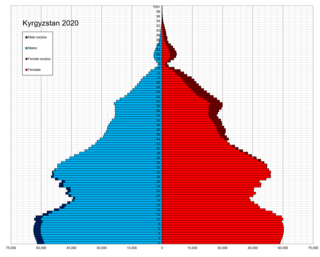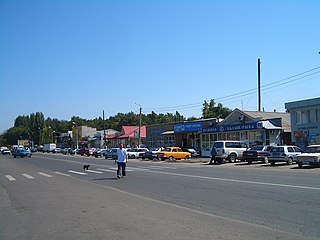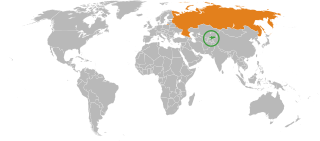External links
| Historical |
| ||||||||||||||||||||||
|---|---|---|---|---|---|---|---|---|---|---|---|---|---|---|---|---|---|---|---|---|---|---|---|
| Diaspora |
| ||||||||||||||||||||||
| See also | |||||||||||||||||||||||
| Ethnic groups |
| ||||
|---|---|---|---|---|---|
| Religion | |||||
There is a small population of Germans in Kyrgyzstan.
| Total population | |
|---|---|
| 8,132 (2021) [1] | |
| Regions with significant populations | |
| Kyrgyzstan, Talas, Bergtal, Chüy Valley |
During the 1800s, groups of Mennonites from Germany settled throughout the Russian Empire; they began to come to the territory which is today Kyrgyzstan in the late 19th century. Many other Germans were brought to the country forcibly, as part of the Stalin-era internal deportations. [2] The 1979 Soviet census showed 101,057 Germans in the Kirghiz Soviet Socialist Republic (2.9% of the population), while the 1989 census showed 101,309 (2.4%). [3]
After Kyrgyzstan gained independence in 1991, there was a significant outflow of ethnic Germans to Germany, due to the relatively liberal German nationality law which granted citizenship to anyone with proof of German ancestry. [2] A 1993 survey found that 85% of the Germans in Kyrgyzstan intended to emigrate; among those, the most popular destination by far was Germany (80%), with Russia running a distant second at 6%. [4] By the time of Kyrgyzstan's 1999 census, just 21,471 (0.4% of the population) remained. [3] German diplomatic officials in Kyrgyzstan were quoted in 2009 as stating that number has declined even further over the following decade, to perhaps just 10,000. [2] This was supported by the 2009 census, which found just 9,487 Germans remaining (0.18% of the population). [5] However, there are signs that the exodus may be coming to an end. Facing difficulties integrating Russian-speaking Germans from the former Soviet Union, the German government tightened their immigration requirements; furthermore, most ethnic Germans who hope to leave Kyrgyzstan have already done so. In 2007, only 196 Germans in Kyrgyzstan were granted immigration permits by the German embassy; that number fell further to 111 in 2008. [2] As of 2021, there were 8,132 Germans in Kyrgyzstan. [1]
The first German settlements in Kyrgyzstan were near Talas: Nikolaipol, Keppental, Gradental, Orlovka and Dmitrovskoye. In the late 1920s, they moved towards the Chüy Valley, in the vicinity of Frunze (now Bishkek), where they established a number of new village-suburbs, including Bergtal (Rotfront), Fridenfeld, and Luxemburg. [6] [7] Others lived in Kant and Tokmok. [6] However, in the exodus of the 1990s, the German villages emptied out, and there are no longer any compact settlements of Germans in the country. [8]
The ethnic Germans of Kyrgyzstan tend to trace their roots to western parts of Germany near the border with the Netherlands, and as such tend to speak varieties of Low German. However, many youth show language shift towards Russian, which they use for communicating with peers of other ethnicities. [2] [7] There is a Bishkek branch of the Goethe-Institut, which promotes German culture and the teaching of the German language; the local head of the Institut is herself an ethnic German born in Kyrgyzstan, who emigrated with her parents in 1978 but then returned to the country nearly three decades later to take up her present post. [6] However, the study of the German language as a second language has been losing popularity even among ethnic German youth, as Chinese and English become of greater economic importance instead. [8]
In the southern city of Jalal-Abad, local ethnic Germans formed the Hope German Cultural Center in 1996. [7] Four Congresses of German Youth of Kyrgyzstan (съезд немецкой молодежи Киргизии) have been held in the country; however, the most recent, in 2010, attracted only 50 participants. The government of Germany provides some monetary support to German organisations in Kyrgyzstan. [8]

Bishkek, formerly Pishpek and Frunze, is the capital and largest city of Kyrgyzstan. Bishkek is also the administrative centre of the Chüy Region. The region surrounds the city, although the city itself is not part of the region but rather a region-level unit of Kyrgyzstan. Bishkek is situated near the border with Kazakhstan and has a population of 1,074,075, as of 2021. Bishkek is the primate city of Kyrgyzstan—it is the sole metropolis in the country, and about 17% of all inhabitants of the country live in Bishkek's metropolitan area.

The Demographics of Kyrgyzstan is about the demographic features of the population of Kyrgyzstan, including population growth, population density, ethnicity, education level, health, economic status, religious affiliations, and other aspects of the population. The name Kyrgyz, both for the people and the country, means "forty tribes", a reference to the epic hero Manas who unified forty tribes against the Oirats, as symbolized by the 40-ray sun on the flag of Kyrgyzstan.

Transport in Kyrgyzstan is severely constrained by the country's alpine topography. Roads have to snake up steep valleys, cross passes of 3,000 m (9,843 ft) altitude and more, and are subject to frequent mud slides and snow avalanches. Winter travel is close to impossible in many of the more remote and high-altitude regions. Additional problems are because many roads and railway lines built during the Soviet period are today intersected by international boundaries, requiring time-consuming border formalities to cross where they are not completely closed. The horse is still a much used transport option, especially in rural and inaccessible areas, as it does not depend on imported fuel.

Kyrgyzstan, officially the Kyrgyz Republic, is a landlocked country in Central Asia, lying in the Tian Shan and Pamir mountain ranges. Bishkek is the capital and largest city of the country. Kyrgyzstan is bordered by Kazakhstan to the north, Uzbekistan to the west, Tajikistan to the south, and China to the east and southeast. Ethnic Kyrgyz make up the majority of the country's 7 million people, followed by significant minorities of Uzbeks and Russians.

Chüy Region is the northernmost region (oblast) of the Kyrgyz Republic. This region surrounds the national capital of Kyrgyzstan, Bishkek. It is bounded on the north by Kazakhstan, and clockwise, Issyk-Kul Region, Naryn Region, Jalal-Abad Region, and Talas Region. Its administrative center is Bishkek. Its total area is 19,895 km2 (7,682 sq mi). The resident population of the region was 974,984 as of January 2021. The region has sizeable Russian and Dungan minorities. It takes its name from the river Chüy, that flows through the region.

Tokmok is a city in the Chüy Valley, northern Kyrgyzstan, east of the country's capital of Bishkek, with a population of 71,443 in 2021. Its elevation is 816 m above sea level. From 2003 to 2006, it was the administrative seat of Chüy Region. Just to the north is the river Chu and the border with Kazakhstan.

Kant is a town in the Chüy Valley of northern Kyrgyzstan, some 20 kilometres (12 mi) east of Bishkek. It is the administrative center of the Ysyk-Ata District. Its population was 22,617 in 2021. Kant was established in 1928.

The Kyrgyz Premier League or OLIMPBET Premier League for sponsorship purposes is the division of professional football in Kyrgyzstan. It was created in 1992 after the Dissolution of the Soviet Union. The league is composed of eight teams. The most successful team is Dordoi Bishkek who have won the league thirteen times.

Ysyk-Ata District is one of the eight districts of the Chüy Region in northern Kyrgyzstan with an area of 2,415 square kilometres (932 sq mi). The district's resident population was 154,340 in 2021. Since 1998, when the former Kant District was merged into Ysyk-Ata District, the administrative center of the district is the city of Kant. The district is located on the southern side of the river Chüy, about halfway between the national capital Bishkek and the former regional capital Tokmok.

Chatkal is a district of Jalal-Abad Region in western Kyrgyzstan. The administrative seat lies at Kanysh-Kyya. Its area is 4,608 square kilometres (1,779 sq mi), and its resident population was 28,625 in 2021.

Kyrgyzstan–Russia relations are the relations between the two countries, Kyrgyzstan and Russia. Russia has an embassy in Bishkek and a consulate in Osh, and Kyrgyzstan has an embassy in Moscow, a consulate in Ekaterinburg, and a vice-consulate in Novosibirsk.
Orlovka is a city in Kemin District of Chüy Region. Its population was 6,167 in 2021. It is the center of Orlovka municipal council that also includes Podgornoye village. Orlovka was established in 1910. It became a city in 2012.

There is a population of Uyghurs in Kyrgyzstan, who mostly came to the country in three separate migrations throughout the 19th and 20th centuries. According to official statistics, they make up about 0.9% of the national population.

Ivanovka is a village in the Ysyk-Ata District of the Chüy Region, of Kyrgyzstan, approximately midway between Tokmok and Kant. Its population was 17,513 in 2021. It is known for its multi-ethnic composition, including Kyrgyz, Russians and Dungans. Its economy focuses on agriculture in the Chüy Valley, Kyrgyzstan's largest northern agricultural area.

The 2010 Kyrgyz Revolution, also known as the Second Kyrgyz Revolution, the Melon Revolution, the April Events or officially as the People's April Revolution, began in April 2010 with the ousting of Kyrgyz president Kurmanbek Bakiyev in the capital Bishkek. It was followed by increased ethnic tension involving Kyrgyz people and Uzbeks in the south of the country, which escalated in June 2010. The violence ultimately led to the consolidation of a new parliamentary system in Kyrgyzstan.
Talas is a town in northwestern Kyrgyzstan, located in the Talas river valley between two mountain ranges. Its area is 13 square kilometres (5.0 sq mi), and its resident population was 40,308 in 2021. It is the administrative headquarters of Talas Region. The town was founded by East Slavic settlers in 1877. To the south is the Besh-Tash valley with the Besh-Tash National Park.The Historic Battle of Talas was also fought here between the armies of the Abbasid Caliphate and the Tang Dynasty in 751. The Abbasids defeated the Chinese Empire.
Russians in Kyrgyzstan form a minority ethnic group numbering 419,600 individuals according to the 2009 census, representing 9.1% of the total population. Most ethnic Russians migrated to the country during the 20th century. The Russian population has been declining since the 1991 breakup of the Soviet Union due to low fertility-rates and to emigration. As of 2015 364,500 Russians and Ukrainians lived in Kyrgyzstan, representing 6.2% of its total population.
Meklis Beyshenovich Koshaliyev is a former football coach and technical director of the Football Federation of Kyrgyzstan.

Taalaibek Baryktabasovich Omuraliev is a Kyrgyz major general and a former Minister of Defense of Kyrgyzstan. He also served briefly as the Chief of the General Staff twice.